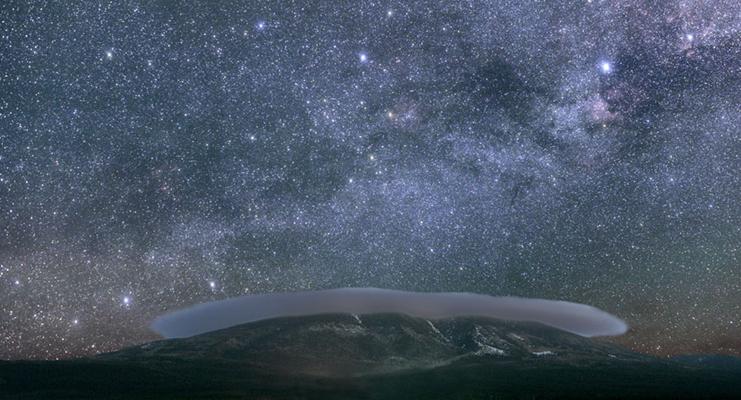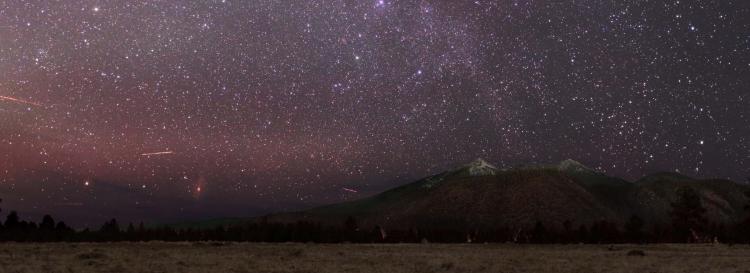Flagstaff Star Party
Most communities would not celebrate visitors feeling left in the dark but for Flagstaff it is a point of pride, part of the very fabric of this lighting-conscious community.

Drive around neighborhoods at night and you’re likely to see street fixtures pointing light downward to the streets rather than upward to the heavens, or the yellow glimmer of specially designed lamps that not only reduce the amount of unnecessary sky glow, but limit the blinding effect common with normal white lights. Welcome to the dark-sky capital of the world, where scientists and citizens stand together in protecting the skies from light pollution.
Dark-Sky Heritage
Local interest in looking skyward started well before electric lights were invented, Flagstaff was founded, Arizona became a state, or the United States even existed. Hundreds of years ago, ancients living in the area of modern-day Wupatki National Monument observed the motions of our nearest star, the Sun, and recorded its changing position on a wall that archaeologists now call Crack-in-Rock.
In the late 1800s, centuries after these earliest sky watchers left, Flagstaff was founded and soon grew into a lumber and livestock community. Yet these residents also looked skyward and apparently felt a similar connection to the night sky, as they nicknamed Flagstaff the “Skylight City” because of the brilliance of the bright stars in contrast to the dark sky.

Images courtesy of Flagstaff Dark Skies Coalition. Image (top of article) courtesy Dan & Cindy Duriscoe, FDSC, Lowell Observatory, USNO
Astronomer Percival Lowell realized the importance of these dark skies for carrying out astronomical research, abandoning East Coast skies polluted by the glow of electric lights for the ink-black ether of Flagstaff. Lowell built his observatory here in 1894, marking the first permanent scientific establishment in Flagstaff—18 years before Arizona achieved statehood. By 1958, the town had grown from rustic western outpost to modern American community, with all the advancements—including a variety of electric lighting—that comes with such growth. Concerned about the negative effects of the increased pollution from artificial lights, Lowell Observatory astronomers worked with Flagstaff community officials to create the world’s first ordinance regulating artificial lighting.
Flagstaff’s astronomical community swelled over the years, with the arrival of several more organizations that realized the scientific value of the area’s dark skies. The U.S. Naval Observatory, U.S. Geological Survey, and Northern Arizona University began research programs that continue to this day, and Lowell Observatory not only continued with its science objectives, but expanded its visitor program into a leading center for informal science education. Meanwhile, amateur astronomy clubs formed and in 1999 the Flagstaff Dark Skies Coalition—an advocacy group for dark skies in northern Arizona—was founded.
This ongoing interest in preserving dark skies culminated in 2001, when Flagstaff was designated as the world’s first International Dark Sky City. This has brought worldwide attention to the area, allowing leaders to further spread the message of dark skies. Jeff Hall, who has leveraged his position as director of Lowell Observatory to fight for dark skies legislation at both local and state levels, calls Flagstaff “the international gold standard for dark sky protection.”
Celebrating Dark Skies
While astronomers have a lot to gain from dark skies, this valuable resource is not limited to their purview. In fact, a common misconception holds that dark skies are only important for astronomers, whose efforts to observe distant stars, planets, and more can be squelched by nearby artificial light that washes out these features. As Chris Luginbuhl, U.S. Naval Observatory retired astronomer points out, “This is like saying that only geologists find significance in the Grand Canyon.” Hall adds, “Dark skies is human health, it’s environmental issues, it’s tourism. It touches the human race—and our fellow inhabitants on this planet—in a variety of life-enhancing ways.”
To share this message, Luginbuhl, Hall, and other local leaders organize and otherwise participate in a variety of activities throughout the year, including a signature event, the Flagstaff Star Party (FSP). Now in its third year, the FSP takes place at Buffalo Park and the nearby NACET parking lot from September 22-24. Live presentations by astronomers, tours of the night sky, and telescope viewing headline the FSP (a full list of activities is available at http://www.flagstaffstarparty.org/). Presented by the Flagstaff Dark Skies Coalition and a handful of community partners, the goal of the FSP is to share Flagstaff’s world-renowned dark skies with people of all ages and educational backgrounds, inspiring them to discover for themselves the wonders of the universe.

Image left courtesy of Flagstaff Festival of Science. Image right courtesy of Flagstaff Dark Skies Coalition.
Luginbuhl says, “It’s not just about enjoying stars, but it’s using that natural connection that most people have or want to have with the wonders and inspiration of the night sky.” Luginbuhl and his fellow organizers see the FSP as a perfect opportunity not only to share this visceral experience, but to also show that dark skies are for everyone—not just scientists—and that dark skies play a significant economical role for Flagstaff and beyond (research dollars, public visitation, support salaries, and other related monies bring in a quarter of a billion dollars per year to the Arizona economy).
Besides all that, the FSP is just a fun experience for people of all ages. Ryan Darr, a detective sergeant with the Flagstaff Police Department, took his two children to last year’s event. He says, “My kids really enjoyed the constellation stories and finding out where the stars were in the sky. Now they go out and like pointing out their favorite ones. They had a great time and we’re definitely going back this year.” What better endorsement for dark skies could you get than these sentiments from two elementary-aged children? As author Shel Silverstein suggested, let’s “Turn on the Dark.”
About the Author

Kevin Schindler
Kevin Schindler is a historian and writer who has called Flagstaff home since 1995. A fixture at Lowell Observatory during that time, he has also been an active member of the Flagstaff community, serving on several boards and committees. He has written more than 400 magazine and newspaper articles on a variety of subjects, particularly science, local history, and baseball. The author of three books, he also contributes a regular astronomy column to the Arizona Daily Sun.